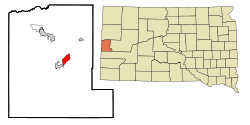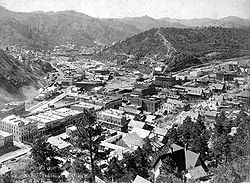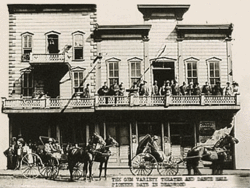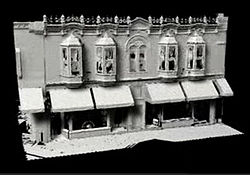- Deadwood, South Dakota
-
For other uses, see Deadwood (disambiguation).
Deadwood, South Dakota — City — Modern Deadwood viewed from Mount Moriah Location in Lawrence County and the state of South Dakota Coordinates: 44°22′36″N 103°43′45″W / 44.37667°N 103.72917°WCoordinates: 44°22′36″N 103°43′45″W / 44.37667°N 103.72917°W Country United States State South Dakota County Lawrence Founded 1876 Government - Type City Commission - Mayor Francis Toscana (elected 2001)[1] Area - Total 4.5 sq mi (11.7 km2) - Land 4.5 sq mi (11.7 km2) - Water 0 sq mi (0 km2) Elevation 4,531 ft (1,381 m) Population (2010) - Total 1,270 Time zone Mountain (MST) (UTC-7) - Summer (DST) MDT (UTC-6) ZIP code 57732 Area code(s) 605 FIPS code 46-15700[2] GNIS feature ID 1265180[3] 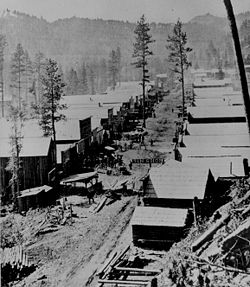 A photograph of Deadwood in 1876. General view of the Dakota Territory gold rush town from a hillside above.
A photograph of Deadwood in 1876. General view of the Dakota Territory gold rush town from a hillside above.
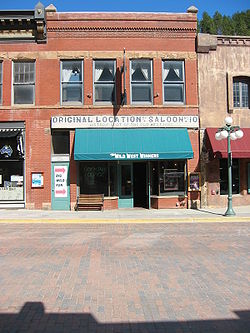 Possible location of the original Nuttal & Mann's saloon where Wild Bill Hickok was killed, 624 Main Street, Deadwood
Possible location of the original Nuttal & Mann's saloon where Wild Bill Hickok was killed, 624 Main Street, Deadwood
Deadwood is a city in South Dakota, United States, and the county seat of Lawrence County. It is named for the dead trees found in its gulch.[4] The population was 1,270 according to a 2010 census. The city includes the Deadwood Historic District, a National Historic Landmark District, whose borders may be the city limits.
Contents
History
19th century
The settlement of Deadwood began in the 1870s and has been described as illegal, since it lay within the territory granted to Native Americans in the 1868 Treaty of Laramie. The treaty had guaranteed ownership of the Black Hills to the Lakota people, and disputes over the Hills are ongoing, having reached the United States Supreme Court on several occasions. However, in 1874, Colonel George Armstrong Custer led an expedition into the Hills and announced the discovery of gold on French Creek near present-day Custer, South Dakota. Custer's announcement triggered the Black Hills Gold Rush and gave rise to the lawless town of Deadwood, which quickly reached a population of around 5,000.
In early 1876, frontiersman Charlie Utter and his brother Steve led a wagon train to Deadwood containing what were deemed to be needed commodities to bolster business. The wagon train brought gamblers and prostitutes, resulting in the establishment of profitable ventures. Demand for women was high, and the business of prostitution proved to have a good market. Madam Dora DuFran would eventually become the most profitable brothel owner in Deadwood, closely followed by Madam Mollie Johnson. Businessman Tom Miller opened the Bella Union Saloon in September of that year.
Another saloon was the Gem Variety Theater, opened April 7, 1877 by Al Swearengen who also controlled the opium trade in the town. The saloon was destroyed by a fire and rebuilt in 1879. It burned down again in 1899, causing Swearengen to leave the town.
The town attained notoriety for the murder of Wild Bill Hickok, and Mount Moriah Cemetery remains the final resting place of Hickok and Calamity Jane, as well as slightly less notable figures such as Seth Bullock. It became known for its wild and almost lawless reputation, during which time murder was common, and punishment for murders not always fair and impartial. The prosecution of the murderer of Hickok, Jack McCall, had to be sent to retrial because of a ruling that his first trial, which resulted in an acquittal, was invalid because Deadwood was an illegal town. This moved the trial to a Dakota Territory court, where he was found guilty and then hanged.
As the economy changed from gold rush to steady mining, Deadwood lost its rough and rowdy character and settled down into a prosperous town. In 1876, a smallpox epidemic swept through the camp, with so many falling sick that tents had to be set up to quarantine them. Also in that year, General George Crook pursued the Sioux Indians from the Battle of Little Big Horn on an expedition that ended in Deadwood, and that came to be known as the Horsemeat March. The Homestake Mine in nearby Lead was established in 1877.
A fire on September 26, 1879 devastated the town, destroying over 300 buildings and consuming everything belonging to many inhabitants. Many of the newly impoverished left town to try their luck elsewhere, without the opportunities of rich untapped veins of ore that characterized the town's early days.
A narrow-gauge railroad, the Deadwood Central Railroad, was founded by Deadwood resident J.K.P. Miller and his associates in 1888, in order to serve their mining interests in the Black Hills. The railroad was purchased by the Chicago, Burlington and Quincy Railroad in 1893. A portion of the railroad between Deadwood and Lead was electrified in 1902 for operation as an interurban passenger system, which operated until 1924. The railroad was abandoned in 1930, apart from a portion from Kirk to Fantail Junction, which was converted to standard gauge. The remaining section was abandoned by the successor Burlington Northern Railroad in 1984.[5]
Some of the other early town residents and frequent visitors included Al Swearengen, E. B. Farnum, Charlie Utter, Sol Star, Martha Bullock, A. W. Merrick, Samuel Fields, Calamity Jane, Dr. Valentine McGillycuddy, the Reverend Henry Weston Smith, and Wild Bill Hickok.
20th and 21st centuries
Another major fire in September 1959 came close to destroying the town. About 4,500 square miles (12,000 km2) were burned and an evacuation order was issued. Nearly 3,600 volunteer and professional firefighters, including personnel from the Homestake Mine and Ellsworth Air Force Base, worked to contain the fire, which resulted in a major regional economic downturn.[6]
The entire town was designated a National Historic Landmark in 1961. However, the town underwent additional decline and financial stresses during the next two decades.[1] Interstate 90 bypassed it in 1964 and its brothels were shut down after a 1980 raid.[1] A fire in December 1987 destroyed the historic Syndicate Building and a neighboring structure.[1] The fire spurred the "Deadwood Experiment", in which gambling was tested as a means of revitalizing a city center.[1][7] At the time, gambling was legal only in the state of Nevada and in Atlantic City.[8] Deadwood was the first small community in the U.S. to seek legal gambling revenues as a way of maintaining local historic qualities.[8] Gambling was legalized in Deadwood in 1989 and immediately brought significant new revenues and development.[9] The pressure of development may have an effect on the historical integrity of the landmark district.[9]
Chinatown
The gold rush attracted Chinese immigrants to the area. Their population peaked at 250.[10] A few engaged in mining; most worked in service enterprises. A quarter arose on Main Street, encouraged by the lack of restrictions on foreign property ownership in Dakota Territory and a relatively high level of tolerance. The quarter's residents also included African-Americans and Americans of European extraction.[11] The state sponsored an archeological dig in the area during the 2000s.[12]
Geography
Deadwood is located at 44°22′36″N 103°43′45″W / 44.37667°N 103.72917°W.[13]
According to the United States Census Bureau, the city has a total area of 4.5 square miles (12 km2) all of it land.
Deadwood has been assigned the ZIP code 57732 and the FIPS place code 15700.
Recreation
In the summer, there are numerous trails for hiking, mountain biking, and horse back riding. The northern end of the George S. Mickelson Trail starts in Deadwood and runs south through the Black Hills to Edgemont. Several man made lakes, including Sheridan Lake, provide fishing and swimming. Spearfish Canyon to the north has many places to rock climb. In early June the Mickelson Trail Marathon and 5K, as well as accompanying races for children, are held.
During the winter there are two ski areas just a few miles outside of nearby Lead, SD – Terry Peak and Deer Mountain.
"The Midnight Star" casino in Deadwood is owned by American film actor Kevin Costner. International versions of many of his films' posters line its walls.
Deadwood in fiction
- Deadwood's history and inhabitants are the foundation of Pete Dexter's 1986 novel, Deadwood, in which Charles Utter, Wild Bill Hickok, and Calamity Jane are the central characters.
- The town's early history forms the basis for the storyline of the HBO TV series named Deadwood.
- In the Star Trek: The Next Generation episode "A Fistful of Datas", the holodeck program that Worf, his son Alexander, and Deanna Troi participate in takes place in 19th-century Deadwood.
- The Tales from Deadwood series of novels by Mike Jameson, published by the Berkley Publishing Group, are set in Deadwood and feature Wild Bill Hickok, Calamity Jane, Al Swearengen, and other historical figures.
- In Flashman and the Redskins, the eponymous hero, an acquaintance of Wild Bill Hickok, ends his adventure in Deadwood in 1876, shortly before Hickok's death.
- The Adam 12 Season 1 episode, "The Long Walk" features an old man who reminisced about his early life in Deadwood.
- A children's book in the Choose Your Own Adventure series is set in Deadwood City[14]
Demographics
Historical populations Census Pop. %± 1880 3,777 — 1890 2,366 −37.4% 1900 3,408 44.0% 1910 3,653 7.2% 1920 2,403 −34.2% 1930 2,559 6.5% 1940 4,100 60.2% 1950 3,288 −19.8% 1960 3,045 −7.4% 1970 2,409 −20.9% 1980 2,035 −15.5% 1990 1,830 −10.1% 2000 1,380 −24.6% 2010 1,270 −8.0% U.S. Decennial Census As of the census[2] of 2000, there were 1,380 people, 669 households, and 341 families residing in the city. The population density was 365.4 people per square mile (141.0/km²). There were 817 housing units at an average density of 216.3 per square mile (83.5/km²). The racial makeup of the city was 95.87% White, 1.88% Native American, 0.36% Asian, 0.65% from other races, and 1.23% from two or more races. Hispanic or Latino of any race were 2.75% of the population. 29.8% were of German, 9.6% Irish, 9.5% English, 9.5% Norwegian and 8.7% American ancestry according to Census 2000.
There were 669 households out of which 20.5% had children under the age of 18 living with them, 37.7% were married couples living together, 10.9% had a female householder with no husband present, and 48.9% were non-families. 40.1% of all households were made up of individuals and 14.6% had someone living alone who was 65 years of age or older. The average household size was 2.01 and the average family size was 2.71.
In the city the population was spread out with 19.3% under the age of 18, 8.7% from 18 to 24, 27.3% from 25 to 44, 27.8% from 45 to 64, and 16.8% who were 65 years of age or older. The median age was 42 years. For every 100 females there were 93.8 males. For every 100 females age 18 and over, there were 92.6 males.
The median income for a household in the city was $28,641, and the median income for a family was $37,132. Males had a median income of $28,920 versus $18,807 for females. The per capita income for the city was $17,673. About 6.9% of families and 10.8% of the population were below the poverty line, including 19.4% of those under age 18 and 8.3% of those age 65 or over.
Radio & TV stations
AM radio
FM radio
Television
Notable natives
- Philip S. Van Cise, (1884–1969), Colorado district attorney
- Jim Scott, (1888–1957), played with the Chicago White Sox
- Ward Lambert, (1888–1958), college basketball coach, mostly with Purdue University
- William H. Parker (1905–1966), former Chief of Police of Los Angeles, California
- Angelo Rizzuto (1906–67), photographer
- Carole Hillard, (1936–2007), Lieutenant Governor of South Dakota 1995–2003
- Dorothy Provine (1937–2010), actress and dancer
- Cris Williamson (b. 1947), singer/musician
- Amy Hill (b. 1953), Japanese-Finnish-American actress
References
- ^ a b c d e "Deadwood gambling spurred change, but the town's evolution continues". Rapid City Journal. November 1, 2009. http://www.rapidcityjournal.com/news/article_573c9312-c585-11de-8182-001cc4c002e0.html. Retrieved November 18, 2009.
- ^ a b "American FactFinder". United States Census Bureau. http://factfinder.census.gov. Retrieved 2008-01-31.
- ^ "US Board on Geographic Names". United States Geological Survey. 2007-10-25. http://geonames.usgs.gov. Retrieved 2008-01-31.
- ^ Deadwood Chamber of Commerce
- ^ Hilton, George W. (1990). American Narrow Gauge Railroads. Stanford, California: Stanford University Press. ISBN 0-8047-2369-9.
- ^ "Historic Wildfire in the Black Hills – Deadwood 1959". National Fire Protection Association. http://www.nfpa.org/assets/files/pdf/blackhills.pdf. Retrieved July 26, 2009.
- ^ Perret, Geoffrey. ""The Town That Took a Chance" American Heritage, April/May 2005.
- ^ a b "Deadwood, South Dakota – Gambling, Historic Preservation, and Economic Revitalization". USDA. http://www.ers.usda.gov/publications/rdp/rdp296/rdp296c.pdf. Retrieved November 18, 2009.
- ^ a b "National Historic Landmarks Program: Deadwood Historic District". National Park Service. http://tps.cr.nps.gov/nhl/detail.cfm?ResourceId=538&ResourceType=District. Retrieved January 10, 2008.
- ^ "Chinese". City of Deadwood. http://deadwood.govoffice.com/index.asp?Type=B_BASIC&SEC=%7BCDB0704A-757E-47EE-8ADB-7345C637CE19%7D. Retrieved November 15, 2010.
- ^ David J. Wishart (2004). Encyclopedia of the Great Plains. University of Nebraska Press. pp. 140, 141. ISBN 9780803247871. http://books.google.com/books?id=rtRFyFO4hpEC&pg=PA165&dq=Chinatown+deadwood#v=onepage&q=Chinatown&f=false.
- ^ "Where East Met (Wild) West". Smithsonian (magazine). http://www.smithsonianmag.com/history-archaeology/Where_East_Met_Wild_West.html. Retrieved November 13, 2010.
- ^ "US Gazetteer files: 2010, 2000, and 1990". United States Census Bureau. 2011-02-12. http://www.census.gov/geo/www/gazetteer/gazette.html. Retrieved 2011-04-23.
- ^ Granger, Edward Packard ; illustrated by Paul (1978). Deadwood City. Toronto: Bantam. ISBN 0553139940. http://www.amazon.com/Deadwood-City-Choose-Your-Adventure/dp/0553139940.
External links
- Deadwood Chamber of Commerce
- Deadwood Historic Preservation Commission
- Deadwood Digital Media Archive (creative commons-licensed photos, laser scans, panoramas), data from a DHPC/CyArk partnership
- Adams House and Museum
Municipalities and communities of Lawrence County, South Dakota County seat: Deadwood Cities Central City | Deadwood | Lead | Spearfish | Whitewood
CDP Township Unincorporated
communitiesHanna | Nemo | Saint Onge
American Old West Towns- Deadwood
- Pine Ridge
- Rapid City
OthersProminent figuresLawmenOutlaws- Billy the Kid
- Black Bart
- Butch Cassidy
- Jesse James and the James-Younger Gang
- Tom Ketchum
- Joaquin Murrieta
- Soapy Smith
- Sundance Kid
- Wild Bunch
Native AmericansOthersTransport and trails Native Americans Folklore - Alma Massacre
- Battle of Fort Tularosa
- Boot Hill
- Dead man's hand
- Frisco Shootout
- Gunfight at the O.K. Corral
- Long Tom's treasure
- Montezuma's treasure
- One-room schoolhouse
- Pecos Bill
- Skeleton Canyon
- Western saloon
- Wild West Shows
Gold rushes Range wars and feuds Lists - Cowboys and cowgirls
- Gangs
- Gunfights
- Lawmen
- Mountain men
- Outlaws
, South Dakota
Categories:- Deadwood, South Dakota
- Black Hills
- Cities in South Dakota
- Populated places in Lawrence County, South Dakota
- American Old West
- County seats in South Dakota
- American folklore
- Chinatowns in the United States
Wikimedia Foundation. 2010.


